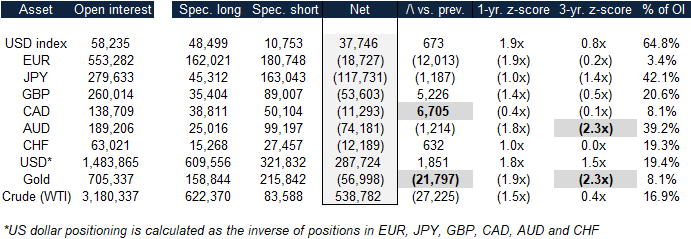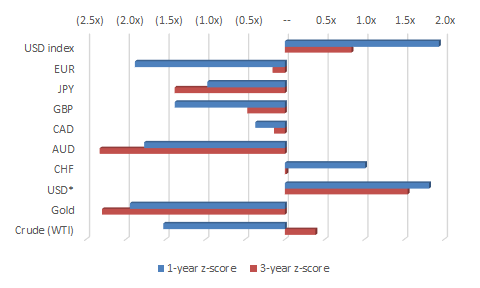Looking at this week’s Commitments of Traders Report, changes in speculator positioning across major currencies and commodities are limited. The only changes worth highlighting can be seen in Canadian dollar and gold positions. Following the successful conclusion of USMCA (formerly NAFTA) negotiations, speculators reduced their short positions against the Canadian dollar by a significant degree. Looking at gold, speculators reduced their long positions in the precious metal this week, causing the overall net short position to rise to a new record for 2018.
Turning to extremes in positioning, the long US dollar net position is no longer at a bullish extreme. In last week’s analysis of the COT Report, we noted that positioning in the US dollar was looking extended based on 12-month averages and the current net position relative to total interest. This week, the only speculator positions that look extended include the short Australian dollar and the short gold position. Both look extended based on the current net position when compared to 36-month averages. When the net speculator position is more than two standard deviations smaller or larger than the trailing 12-month or 36-month average, we flag the position as an extreme.
The purpose of this weekly report is to track how the speculator community is positioned across various major currencies and commodities. When net long positions become crowded in either direction, we flag extended positioning as a risk. Crowded positions do not suggest an imminent reversal, but should be considered as a significant risk factor when investing in the same direction as the crowd. This is shown below:
CFTC COT speculator positions (futures & options combined) – October 9, 2018

Source: CFTC, MarketsNow
Notable extremes, significant changes in weekly positions, and large net positions as a proportion of open interest are highlighted in gray above. Extremes in net positions are highlighted when speculator positioning is more than two standard deviations above trailing 1-year and 3-year averages. Weekly changes are highlighted when they are significant as a proportion of open interest. Finally, net positions as a proportion of outstanding interest are highlighted when they are large relative to historical averages. 1-year and 3-year z-scores are visually represented below:
1-year and 3-year z-scores based on net speculator positions

Source: CFTC, MarketsNow
Thanks to accelerating US growth and inflation over the past few quarters, markets increasingly expect the Federal Reserve to continue raising interest rates. In turn, both the US dollar and US Treasury bond yields have been surging, weighing on gold prices. As a precious metal, gold prices are sensitive to monetary policy expectations. When markets bet on higher interest rates, gold tends to weaken as a result.
This phenomenon can also be seen in speculator positioning. After net positions in gold futures and options peaked at +211,878 contracts in late March, speculators have cut their gold long positions aggressively. After moving to a net short position in early August, speculators have since increased their bets against the precious metal.
Whether or not gold continues to weaken remains to seen. While the dollar’s continued ascent is likely to continue weighing on gold prices, decelerating inflation (which tends to cause lower Treasury bond prices) is a positive factor for the precious metal. For traders looking to buy gold, we suggest waiting for a bullish trend and for more attractive entry prices. Trading ranges and trends for the precious metal are updated daily in our gold daily update.
Any opinions, news, research, analyses, prices or other information contained on this website is provided as general market commentary and does not constitute investment advice. MarketsNow will not accept liability for any loss or damage including, without limitation, to any loss of profit which may arise directly or indirectly from use of or reliance on such information.
Recommended Content
Editors’ Picks

EUR/USD attacks 1.0800 ahead of EU inflation data
EUR/USD is battling 1.0800 in the early European session on Tuesday, undermined by the latest US Dollar bounce. Traders keenly await the EU inflation data and the US jobs survey for further impetus as US President Trump's 'reciprocal tariffs' announcement looms on Wednesday.

GBP/USD treads water above 1.2900 ahead of US data, tariffs
GBP/USD is trading on the defensive while holding above 1.2900 in Tuesday's European trading. The pair loses ground amid a modest US Dollar uptick as traders resort to repositioning in the lead-up to the top-tier US economic data releases and Wednesday's tariffs announcements.

Gold price eases from record high; bullish bias remains amid worries over Trump's tariffs
Gold price retreats slightly after touching a fresh all-time high on Tuesday as bulls pause for a breather and opt to wait for US President Donald Trump's reciprocal tariffs announcement. Adding to this, a positive tone around the Asian equity markets also acts as a headwind for the commodity amid overbought conditions on the daily chart.

PEPE could rally to double digits if it breaks above its key resistance level
Pepe memecoin approaches its descending trendline, trading around $0.000007 on Tuesday; a breakout indicates a bullish move ahead. Moreover, PEPE's long-to-short ratio supports a bullish thesis as bullish bets among the traders reach the highest over a month.

Is the US economy headed for a recession?
Leading economists say a recession is more likely than originally expected. With new tariffs set to be launched on April 2, investors and economists are growing more concerned about an economic slowdown or recession.

The Best brokers to trade EUR/USD
SPONSORED Discover the top brokers for trading EUR/USD in 2025. Our list features brokers with competitive spreads, fast execution, and powerful platforms. Whether you're a beginner or an expert, find the right partner to navigate the dynamic Forex market.